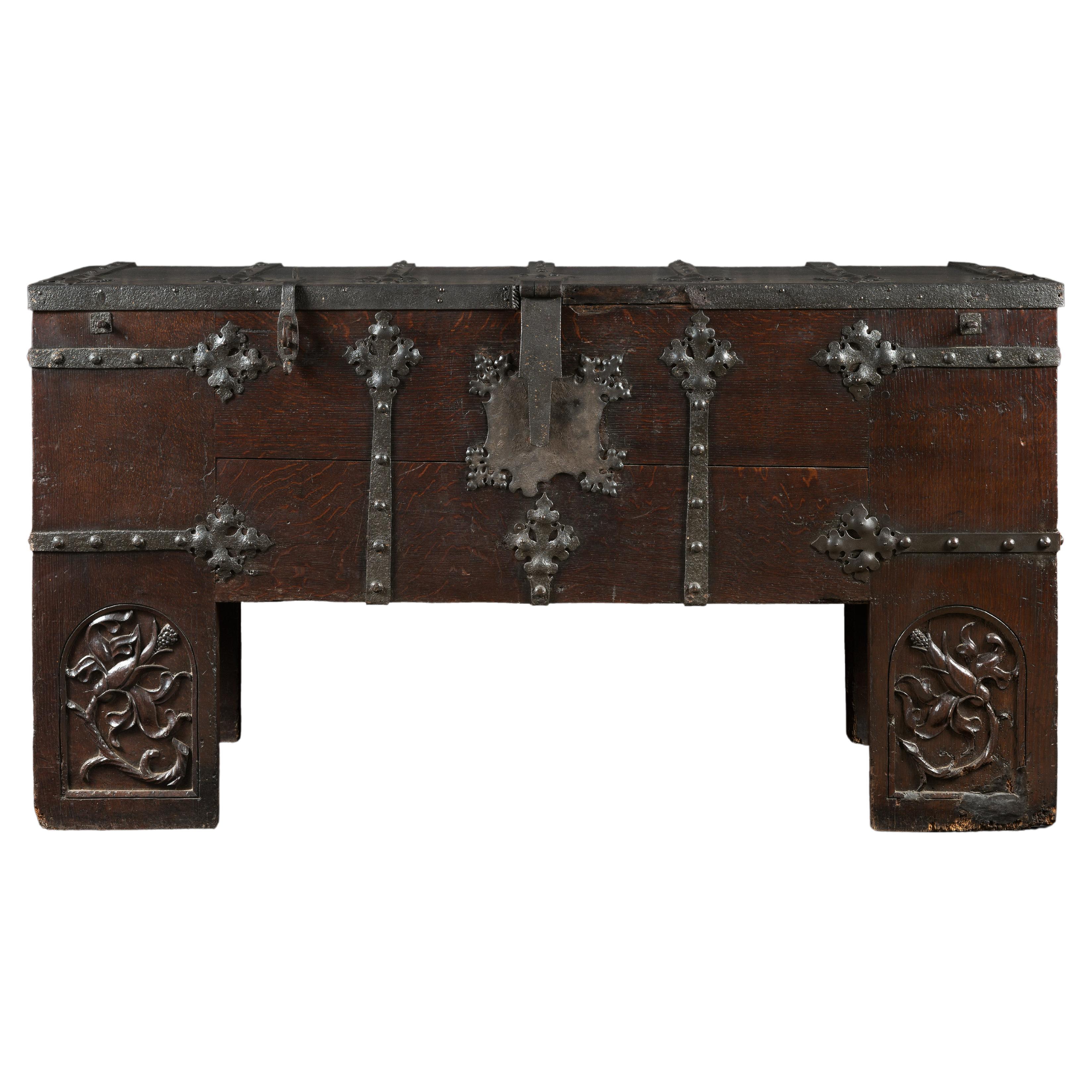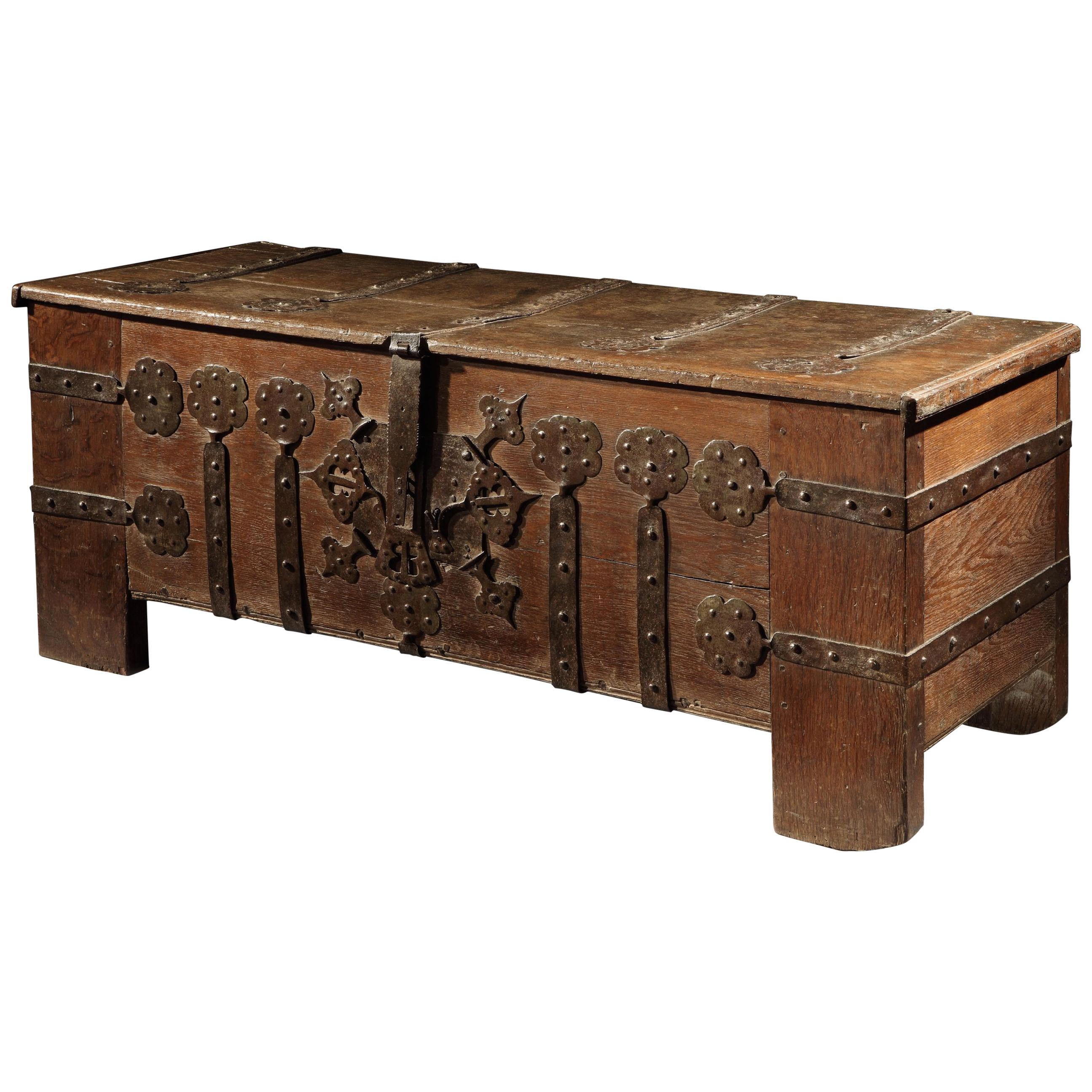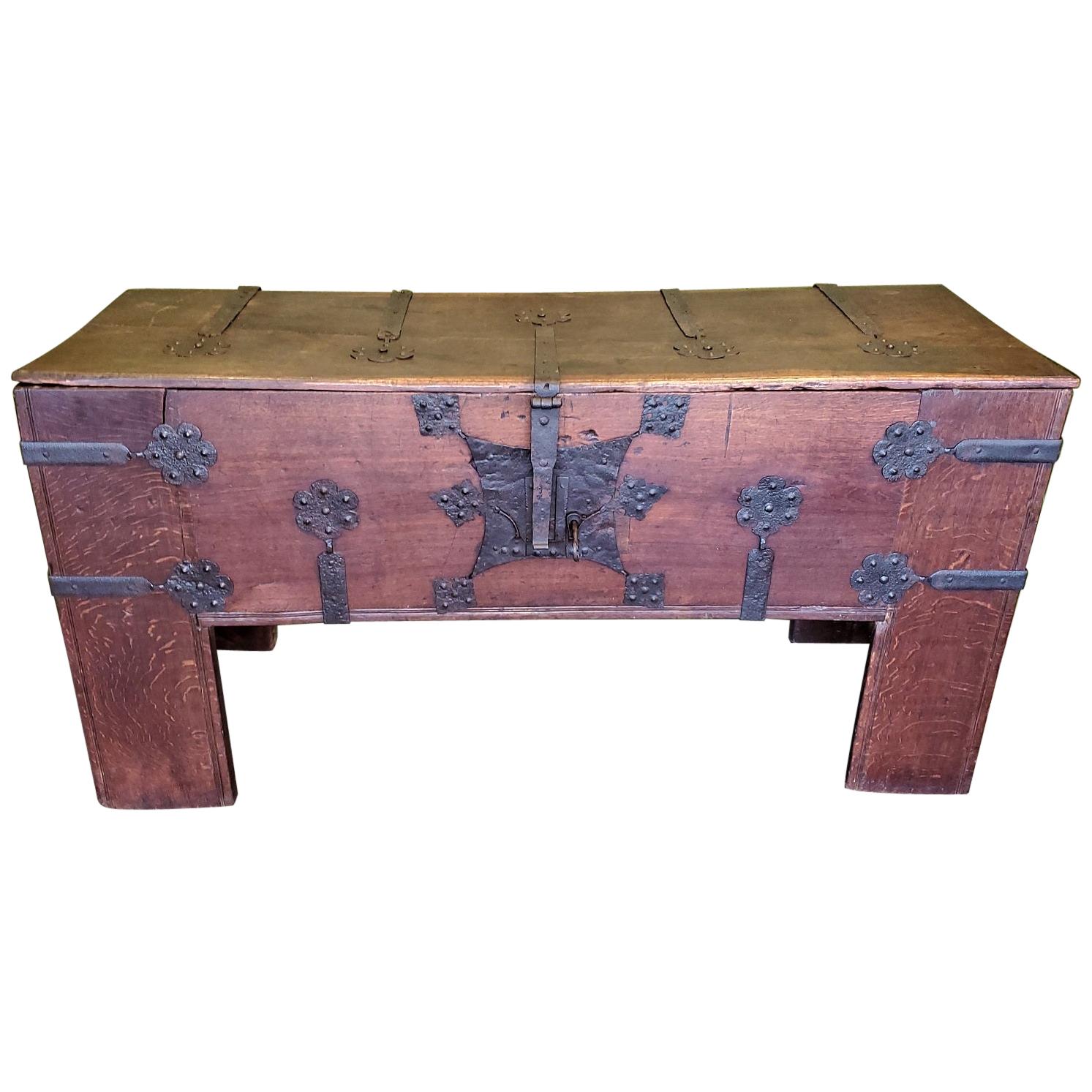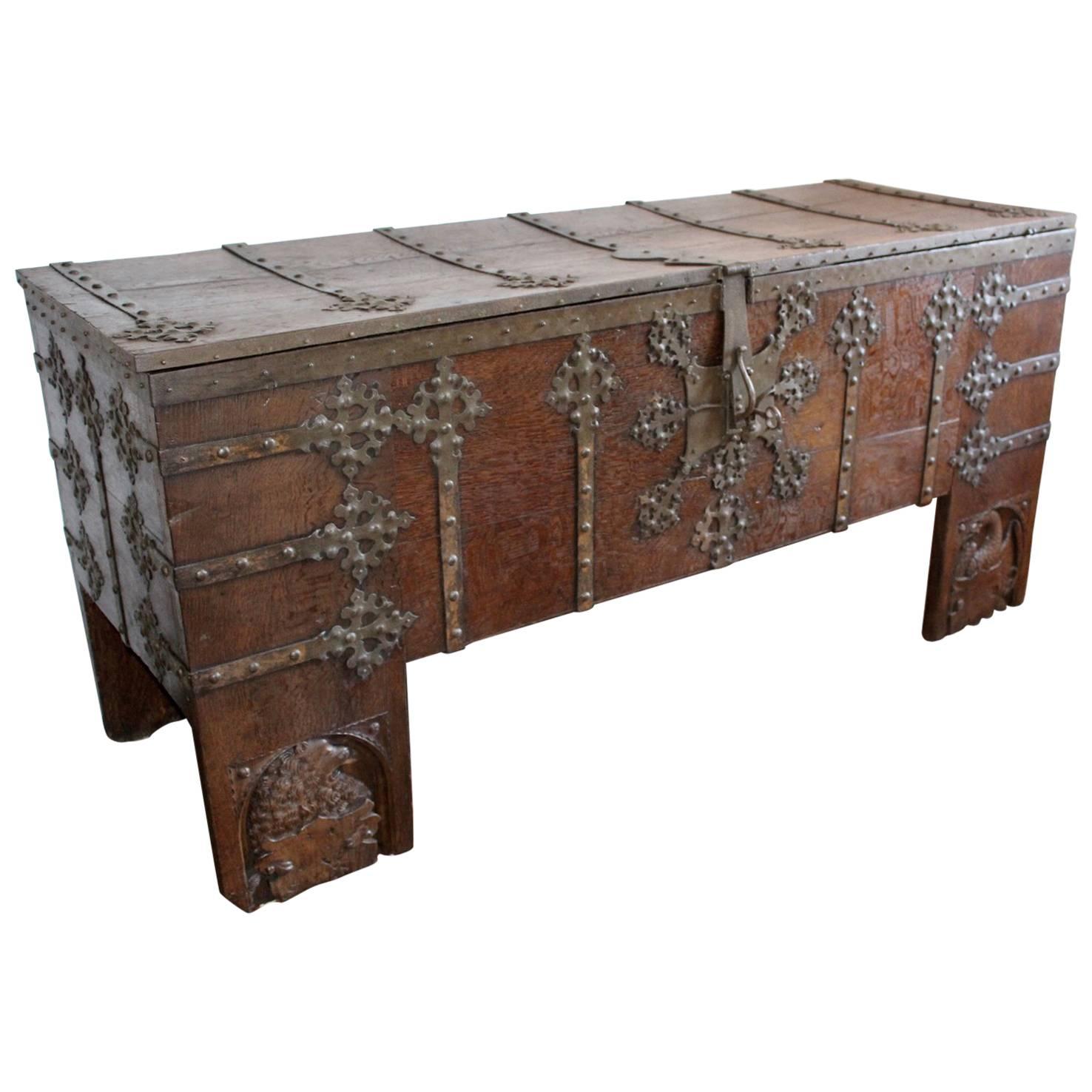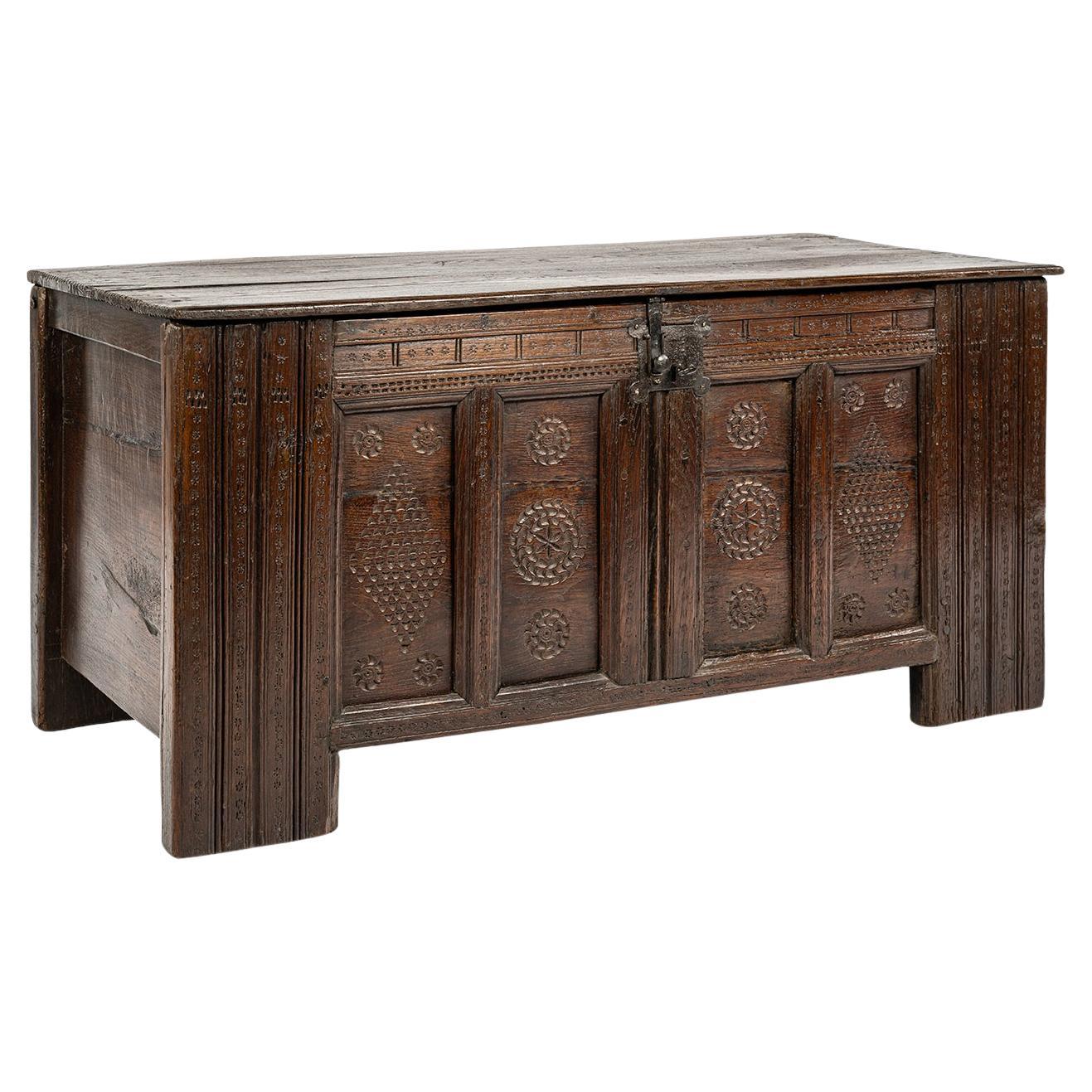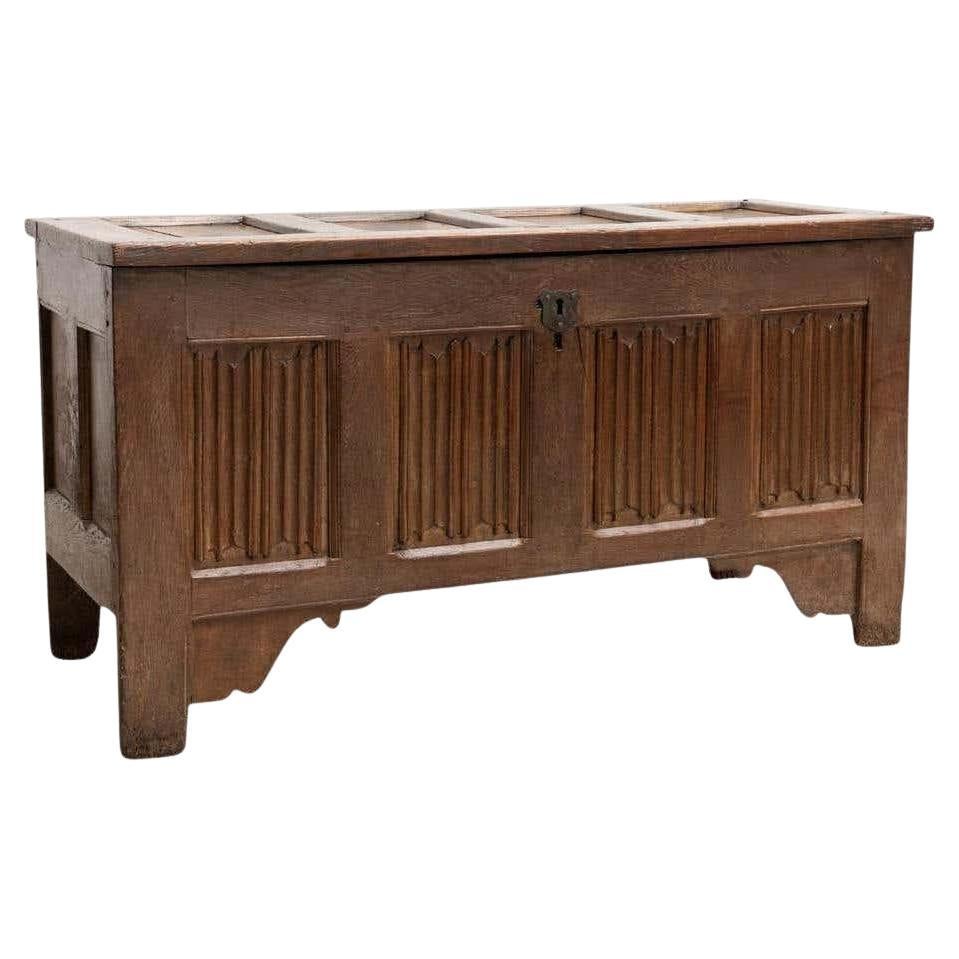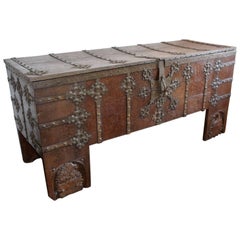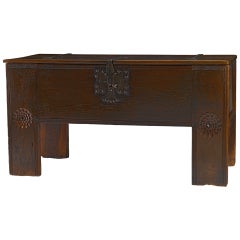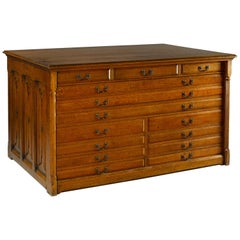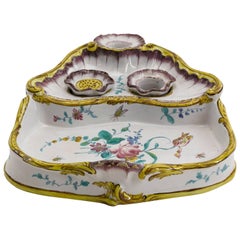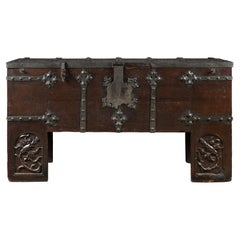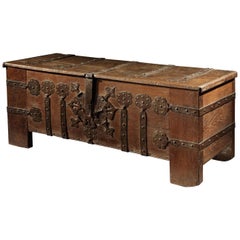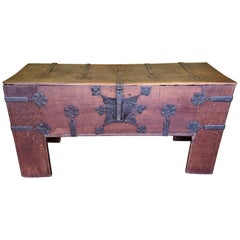Items Similar to Rare Gothic German Oak and Iron Chest Known as "Stollentruhe" 16th century
Want more images or videos?
Request additional images or videos from the seller
1 of 7
Rare Gothic German Oak and Iron Chest Known as "Stollentruhe" 16th century
$29,526.40
£22,228.86
€25,000
CA$40,674.56
A$45,552.94
CHF 23,768.78
MX$556,409.59
NOK 302,408.03
SEK 285,055.80
DKK 190,303.38
About the Item
The large rectangular standing chest on stile feet, extensively mounted with wrought ironwork straps with stylised sixfoil motif. These are fixed with convex head nails: running vertically up the front six straps; running around both sides, three C-shape horizontal straps; running from the back to the front of the lid nine long straps.
On the chest front, centrally placed, is a large, quatrefoil iron lockplate with four corner trefoil finials and two more superimposed trefoil finials, which receives a corresponding external hasp fitted to the lid.
HISTORICAL CONTEXT NOTE
This type of large rectangular standing chest in oak, elaborately mounted with long ironwork straps, is known as a 'stollentruhe' (from its construction using thick boards 'stollen') and was made from at least 1170 (dated by dendrochronology), and continued to be made into the 17th century. Distinctive features include: the vertical ends (as opposed to slanted ends held by rails); the 'clamp-front' method of construction, by which a large front board is jointed into full-height stiles using a single, long tenon; a lid with small or no overhang held on two hinges. Some make prominent use of metal bands; others incorporate carved decoration on the front legs.
The type has become closely associated with northern Westphalia (in central, western Germany). Although certain examples are fitted with carrying handles (and although all chests are portable to some extent), the great weight of this type of chest (approx. 100 kg empty), the plain backs and decorative carving and ironwork indicative that they were essentially static pieces of furniture - combining large storage capacity and a reasonable measure of security with conspicuous display. In addition to their impressive proportions and height off the ground (keeping the contents away from damp or dirty floors), their most showy aspect was the wrought and cut ironwork mounts. The multiple iron straps fulfil a dual role: principally decorative but also reinforcing the structural wood joints. Evidently such chests were intended to be secure: the timbers and hinges (a notorious weakpoint of chests) are notably robust and some examples are fitted with additional hasps.
The central lock-plates on these chests are particularly impressive but in terms of security represent the weak point of the chest. In the same way as keys were displayed as a badge of status by officers of the household and women in medieval Europe, ornate locks on doors and chests were part of a concern to draw attention to household wealth and its distribution on controlled terms. Whatever the contents of such chests, they were a way to assert the authority of the owner.
FUNCTION
Chests (of all shapes and sizes) were the most common form of furniture in late medieval households. Even poor households are likely to have had at least one, while the inventories of great households can list hundreds. They were used to hold all manner of goods: coin, plate and personal jewels, clothes and textiles, vestments and chapel ornaments, muniments, books,
arms and armour, lights, grain and bread. A practical disadvantage of large chests was accessing contents especially smaller objects at the bottom. Most chests of any quality have a built-in, lidded compartment or 'till' across one or both ends. These must have been convenient for smaller valuables (and perhaps candles), and some were fitted with their own lock.
Baumeier argues that 'stollentruhe'chests were commissioned by the urban bourgeoisie (for example rich merchants and farmers), especially for a new wife’s trousseau. They were used by both women and men, principally used for clothing and textiles but also containing weapons (harness and swords), documents, jewellery and money. After the death of the owner the contents (if clothing or metal objects) is sometimes recorded as remaining in the chest until the heirs come of age. They are generally fitted with a lockable container (Beilade) or till at the right or left side.
Literature
• Baumeier, Stefan, Beschlagene Kisten; Die ältesten Truhen Westfalens, Essen, 2012.
• Falke, Otto von, Deutsche Möbel des Mittelalters und der Renaissance, Stuttgart, 1924, Abb.: Tfl. 85, 86 und 87.
• Kreisel, Heinrich, Die Kunst des deutschen Möbels, Von den Anfängen bis zum Hochbarock, München, 1968, Band I, Abb.: 45, Sammlung Kurpfälzisches Museum, Heidelberg.
• Stülpnagel, Karl Heinrich von, Die gotischen Truhen der Lüneburger Heideklöster, Cloppenburg, 2000.
• Windisch-Graetz, Franz, Möbel Europas, Band I, Von der Romanik zur Spätgotik, München, 1982, Abb.: 146, Sammlung Germanisches Nationalmuseum, Nürnberg.
++++ Upon request, we will gladly send you a detailed dossier on this object. ++++
- Dimensions:Height: 28.75 in (73 cm)Width: 71.66 in (182 cm)Depth: 25.99 in (66 cm)
- Style:Gothic (Of the Period)
- Materials and Techniques:
- Place of Origin:
- Period:
- Date of Manufacture:1500-1550
- Condition:Repaired: This item is in good antique condition, with minor historic marks, wear, and imperfections consistent with age and use; minor repairs to the ironwork,. Wear consistent with age and use. Minor losses. Minor structural damages.
- Seller Location:Worpswede / Bremen, DE
- Reference Number:Seller: 31821stDibs: LU981446089242
About the Seller
5.0
Recognized Seller
These prestigious sellers are industry leaders and represent the highest echelon for item quality and design.
Established in 1979
1stDibs seller since 2013
27 sales on 1stDibs
Typical response time: 1 to 2 days
- ShippingRetrieving quote...Shipping from: Worpswede / Bremen, Germany
- Return Policy
Authenticity Guarantee
In the unlikely event there’s an issue with an item’s authenticity, contact us within 1 year for a full refund. DetailsMoney-Back Guarantee
If your item is not as described, is damaged in transit, or does not arrive, contact us within 7 days for a full refund. Details24-Hour Cancellation
You have a 24-hour grace period in which to reconsider your purchase, with no questions asked.Vetted Professional Sellers
Our world-class sellers must adhere to strict standards for service and quality, maintaining the integrity of our listings.Price-Match Guarantee
If you find that a seller listed the same item for a lower price elsewhere, we’ll match it.Trusted Global Delivery
Our best-in-class carrier network provides specialized shipping options worldwide, including custom delivery.More From This Seller
View AllRare Late Medieval 16th Century German Wrought Iron Oak Chest or Stollentruhe
Located in Worpswede / Bremen, DE
A very impressive Westphalian Gothic chest or ‚Stollentruhe’, Westphalia, Germany, circa 1500-1550. Wrought iron mounted oak, partially carved. The monumental rectangular standing chest with full-height stiles, extensively mounted with wrought ironwork straps terminating in quatrefoil finials which ’wrap’ around the chest edges. These are fixed with convex head nails. The ironwork with some remains of an originally red painted surface. In addition, running along the edges of the lid at the front and sides is a plain iron band, close-nailed. The feet of the two front legs are finely carved on the front face, in low relief with a rectangular arched ’panel’ depicting on the left a lion, on the right a dragon holding each a coat of arms.
Regarding the age of circa 500 years, this coffer is in exceptionally good condition, with only smaller restorations.
Comparative literature
• Baumeier, Stefan, Beschlagene Kisten; Die ältesten Truhen Westfalens, Essen, 2012.
• Falke, Otto von, Deutsche Möbel...
Category
Antique 16th Century German Medieval Blanket Chests
Materials
Iron
17th Century German Iron-Mounted Oak Chest / Trunk "Stollentruhe"
Located in Worpswede / Bremen, DE
A 17th century German oak chest ("Stollentruhe") in the medieval/ Gothic tradition. The rectangular hinged top with three iron straps, enclosing a plain interior with one hinged smal...
Category
Antique 17th Century German Baroque Commodes and Chests of Drawers
Materials
Oak
Rare Victorian Mid-19th Century Gothic Revival Library Architects Plan Chest
Located in Worpswede / Bremen, DE
A neo-gothic mid-19th century library plan chest having an arrangement of eleven short and three long drawers to one side, the other side with three short drawers above gothic style linen fold panelling, centred with the carved monogram ‘HP’, further matching panelling to the sides. A stunning plan chest of good propartions and with a nice patina. Provenance: Sherborne School, an independent school in north-west Dorset, England, established in 1550. Among the ‘Old Shirburnians’ are for example the writer John Cowper Powys, the actors Jeremy Irons und Charlie Cox, Chris Martin, leadsinger of the band Coldplay as well as Sheikh Tamim bin Hamad Al Thani...
Category
Antique Mid-19th Century English Gothic Revival Commodes and Chests of D...
Materials
Oak
Rare 18th Century German Faience Rococo Encrier Inkstand Stockelsdorf
Located in Worpswede / Bremen, DE
The form of this rare encrier is based on the model of the known faience master Johann Georg Buchwald, who produced it first in the manufacture of Marieberg, later also in Eckernförd...
Category
Antique Late 18th Century German Rococo Inkwells
Materials
Faience
Rare 17th Century Baroque Cabinet, South Germany Probably Augsburg, Wunderkammer
Located in Worpswede / Bremen, DE
A small architectural table cabinet, veneered in walnut and mulberry, the centre doors enclosing an arrangement of nine various sized drawers with bone knobs, behind a central door a...
Category
Antique Late 17th Century German Baroque Cabinets
Materials
Brass
Rare German Rococo 18th Century Period Console Table with Marble Top
Located in Worpswede / Bremen, DE
A very unusual and superb Rococo console table from the mid-18th century. On four carved legs with an X-shaped stretcher, overall with scrolls and dolphin-like sea creatures. This ex...
Category
Antique Mid-18th Century German Rococo Console Tables
Materials
Marble
You May Also Like
Rare Gothic German Oak and Iron Chest Known as "Stollentruhe"
Located in Saint-Ouen, FR
This large chest stands on high legs prolonging the lateral jambs. Presenting a sober and severe appearance the chest still belongs to the Medieval tradition. The piece is made from very high quality Hungarian wood.
The jambs are joined to the facade and the lateral sides thanks to pegged mortise and tenon securing a great stability and squareness between each parts. The upper lid is made of two joined parts and so is the facade.
The ironwork is present all over the surface of the chest and brings both an additional stability to the construction as well as a rich decor. The lid is secured with hinges. Hinges also run all over the chest in horizontal and vertical lines, ending in a floral motif. The hasp lock is also very ornamental.
Those chests always present important proportions especially when they are made early in the period. This model was very popular in Germany and stayed in vogue until the 16th century. However the feet Gothic decor...
Category
Antique 15th Century and Earlier German Gothic Blanket Chests
Materials
Wrought Iron
Chest or Stollentruhe, Early 16th Century, German Gothic, Oak Chest, Original
Located in BUNGAY, SUFFOLK
This standing chest is of clamp-front construction, extensively decorated with long, ironwork straps with quatrefoil finials which ‘wrap’ around it, and has an ornate, central lockplate, and front legs with full, height stiles. The ironwork straps and finials are fixed with convex, headed nails: running along the front, five long straps; the two side straps; and the five straps on the top. On the chest front, centrally placed, is a large, iron lockplate with four outer, radiating spade finals in each corner and three, superimposed spade finials (a symbol of nobility) which are pierced with the initials ‘BB’. The lockplate receives a corresponding, external hasp fitted to the lid. Below the floor of the chest, the two front stile legs retain most of their original height. The lid is supported by substantial iron strap hinges that extend right down the back of the chest. Inside the chest at the left end is a shallow, oak till.
Construction The chest is of joined, 'clamp-front' construction, reinforced by the nailed, iron mounts. In total it uses ten, oak boards which were riven and planed. The back and front are each formed from a large single plank held to the full height stiles by long, pegged tenons. The sides are also single boards joined into the stiles using long tenons held by dowels, and extend down below the chest bottom, concealing the ends of the bottom boards. The bottom consists of a single board cut into the sides and shallow rebates in the stiles. The front and back boards are dowelled into the bottom boards. The lid which overhangs the sides has a narrow cleat at each end, and consists of one wide plank which has bowed a little as a result of shrinkage.
Ironwork : The wrought ironwork straps, lockplate, hasp and lock all appear all appear to be early, and of the same original manufacture and are fixed with convex headed nails. There is mild dark staining of the oak around the iron mounts, possibly because of low tannin content in the oak.
Length 172 cm., 67 ¾ in., Height 71.5 cm., 28 ¼ in., Depth 63 cm., 24 ¾ in.,
Related to: No 900:2-1904 V&A Museum, London. Stadtmuseum Dusseldorf. Decorative Arts Museum Berlin. Museen Schleswig-Holstein & Hamburg. A related example featuring elaborately-carved feet and formerly in the Horsham Museum, West Sussex, sold at Christie's in 2010 for £97,250 and another example, again with carved feet sold at Sothebys in 2006 for £48,000.
Literature: A similar example is illustrated in H. Lüttgens, Alt- Aachener Wohnkultur; Ein Rundgang durch ein altes Aachener Haus im Wohnstil des 18. Jahrhunderts, Aachen, n.d., ill. 12, and another comparable iron-bound chests...
Category
Antique 16th Century German Gothic Blanket Chests
Materials
Oak
Rare (Late Medieval) 16th Century German Wrought Iron Oak Chest or Stollentruhe
Located in Dallas, TX
WE HAVE THE PLEASURE TO PRESENT an Exceptionally Rare (Late Medieval) 16th Century German Wrought Iron Oak Chest or Stollentruhe.
This is an Early...
Category
Antique 16th Century German Gothic Blanket Chests
Materials
Wrought Iron
Gothic 16th Century Wood Chest
Located in Barcelona, Barcelona
Gothic oak chest from 16th century with paneled lid and 4 linenfold panels in the front,
circa 1500-1530
From the low countries, (Netherlands).
In good original condition, with min...
Category
Antique 16th Century Dutch Gothic Blanket Chests
Materials
Oak
$8,233 Sale Price
30% Off
Antique 16th Century German Dark Brown oak carved Stollentruhe Trunk or Chest
Located in Casteren, NL
This impressive large Stollentruhe, also known as a Stollentroewe, is a large German storage chest crafted around 1580. Its distinctive construction, with massive upright corner post...
Category
Antique 16th Century German Medieval Blanket Chests
Materials
Steel
Antique 16th Century German Dark Brown oak carved Stollentruhe Trunk or Chest
Located in Casteren, NL
Rare and early German Stollentruhe, dating from around 1620. This compact 17th-century oak chest combines historical significance with visual prese...
Category
Antique Early 17th Century German Renaissance Blanket Chests
Materials
Steel
More Ways To Browse
Antique Wooden Crate Storage Box With Lid
Japanese Tin Lined Tea Storage Box
18th Century Italian Baroque Cassone
Zanzibar Teak And Brass Chest
Chinoiserie Wicker Chest
Hong Kong Camphor Chest
Lane Cedar Chest With Lock
Vintage Ammo Case
Wicker And Brass Chinoiserie Trunk
Lane Acclaim Cedar Chest
Pennsylvania Dower Chest
Vintage Military Trunk Chest
Antique Six Board Blanket Chest
Cavalier Cedar Chest Vintage
Indian Damchiya
Mexican Wedding Chest
Swat Valley Chest
Tudor Coffer
